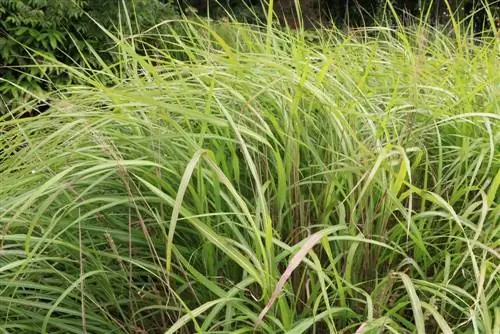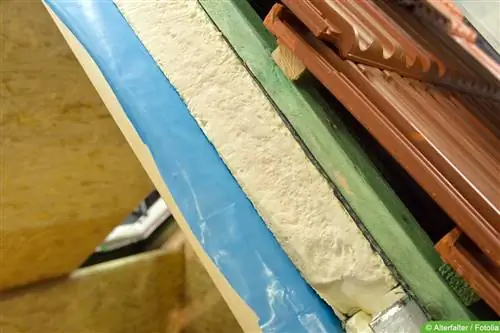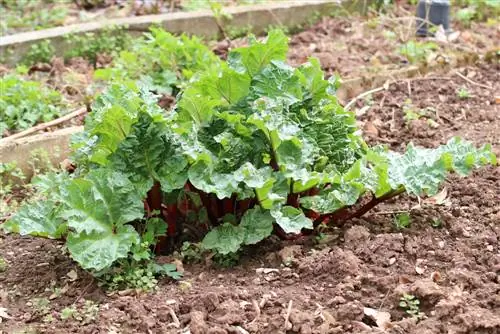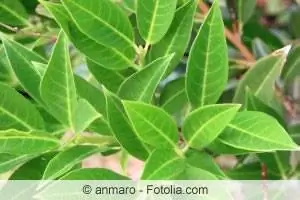- Author admin [email protected].
- Public 2023-12-17 03:39.
- Last modified 2025-06-01 06:48.
So-called root barriers are used to prevent roots from spreading far. These ensure local limitation of root growth. Miscanthus from the plant genus Miscanthus is basically one of the plants that form fewer runners. But under certain circumstances they can spread widely and cause damage, especially in specific locations. You can find out how you can prevent this with a rhizome and how you should proceed in the following instructions.
Location
Miscanthus is an extremely robust plant that will decorate gardens for many years. As it ages and grows, the root system also grows. This burrows its way through the earth to a length and/or width of several meters. Depending on the constitution of the Miscanthus, these roots can appear in clusters and cause damage within a radius of four to five meters.
Especially miscanthus, in the vicinity of which there is a pond with foil, a well-kept lawn, paved paths, electrical cables or water and sewage pipes, should be provided with a rhizome as a precaution. The growth force and the amount of roots are capable of damaging insulation, metals and plastics and blocking pipes or pipes.
They can push up cobblestone paths and even ruin the foundations of buildings, resulting in costly repairs in the worst case scenario. It is therefore essential that miscanthus in particular is surrounded by a rhizome block if they are in the immediate vicinity of the location with already mentioned or similar risk factors.
Time
The root barrier for miscanthus should ideally be set when planting. This saves work, time and effort. It also provides immediate protection and the roots can spread to a predetermined size right from the start. If you have already planted this type of reed, you can also add rhizome blocks later. However, this requires uncovering or even digging up the plant so that the soil area can be optimally equipped with the root barrier. This is much more difficult and time-consuming than immediately planting a barrier for roots.
Since planting, transplanting and planting miscanthus is only advisable in spring or late summer, this is also the period in which rhizome barriers should be used.
It is also advisable to choose a dry, sunny day to insert root barriers. Especially when working with glue, it dries better in these weather conditions. This minimizes the risk of adhesive weak spots and subsequent penetration of dirt and/or soil.
Texture
In order to achieve perfect functionality in the long term, the nature of the material must be taken into account when choosing a rhizome barrier. This is due, among other things, to the robustness of the material, which has to withstand the pressure of the roots. The inside should be such that the root ends cannot get stuck there, as this increases the pressure on the material over time. It should also be weatherproof, tolerate frost, not rust and therefore have a long service life.
fleece
A material made of fleece is ideal. Many professional gardeners are increasingly relying on fleece because it is easy to process, reliably prevents roots from spreading uncontrollably and is neither sensitive to frost nor rusts. The special, high-quality fleece has a very smooth structure on the inside so that the root ends cannot dock there. But the water permeability of fleece is particularly advantageous. This allows excess water to drain in all directions, which is not the case with some other materials and thus increases the risk of waterlogging.
However, the so-called root fleece or spun fleece is usually only offered by the meter. This means that the two ends have to be joined together, creating a weak point that may not be able to withstand the pressure of the roots in the long term. In addition, the special root barrier fleece is quite expensive to purchase compared to other methods.
Plastic
Specialist retailers mainly offer root barriers made of high-pressure polyethylene. Depending on the material thickness, these are among the most robust designs. These are also usually sold by the meter and glued at the ends. There is therefore a possible vulnerability here too. You can strengthen the end connections a little by buying an HDPE set with locking or clamping rails. The ends are each provided with a rail, which are then connected to each other with screws. This creates a solid curve that has significantly more pressure potential than glued together ends.

Tip:
When purchasing HDPE rhizome barriers with locking rails, make sure that the latter is made of rust-resistant material such as aluminum. You should also pay attention to the screws to ensure a long shelf life in moist soil.
Alternatives
While special roofing foil, such as that used for flat roofs, is definitely not suitable for bamboo with severe root loss, it is a good alternative for the Chinese reed roots, which have less shedding. Theoretically, this roof film could also be fitted with clamping rails, as these can also be purchased separately. However, there is a risk that, due to the thickness of the film, the clamping rails cannot be attached perfectly and gaps could arise through which the roots can push their way. A better alternative would be to weld the ends of the roof foil.
You can avoid the problem with the weak points at the end connections by using, for example, a rain barrel, a mortar bucket or a similarly functioning tub made of plastic or concrete. These are available quite inexpensively at any well-stocked hardware store for little money. When it comes to the plastic, it should be taken into account that it is polypropylene so that the material is sufficiently robust and can withstand the pressure of the growing roots. For buckets, barrels and vats, simply cut out the bottom and place it in the planting hole.
Size
A commercially available barrier for root growth is usually two millimeters thick and at least 70 centimeters high. The roots of the Chinese reed do not extend very far, but if you still want to be on the safe side, you should choose a width of 100 centimeters. The required length of the root barrier depends on the diameter of the planting hole into which the miscanthus is planted.
This diameter is multiplied by three and the result is the lock length. When subsequently setting a root control, the size of the excavated soil depends primarily on the size of the plant. Here, experts recommend using the outer edge of the plant as a basis for calculation.
Proceed as follows:
- Place four opposite points on the outermost sides of the reeds
- Draw a straight line about two to three meters long from the points away from the plant
- Set marker points here again
- Now connect the outer points together to define the edge of the upcoming excavation
- As an alternative to diameter marking, you can set and connect the points with spade stitches
- Measure the diameter
- The required length results from: diameter x 3
Basically, when determining the length, you should note that the miscanthus needs enough space for the roots and the soil to provide nutrients and moisture. It is also important to consider whether the miscanthus would like to be slowed down or encouraged in its growth. If it is to be larger, the root should of course be given more space to expand and the root blockage should be selected correspondingly larger in diameter. But it should never be less than the length resulting from the diameter calculation as described above.
Procedure
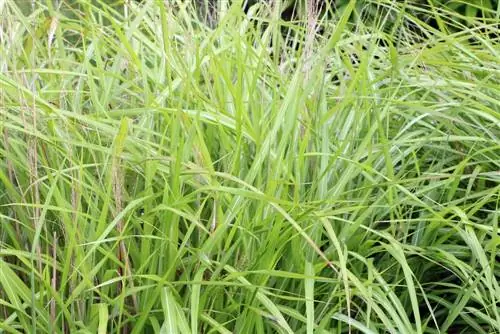
Whether you want to plant it for the first time or whether you want to use a barrier for the roots of a miscanthus afterwards is irrelevant. In principle, you proceed in the same steps in both cases, although if you add them later you will of course have to dig out the reeds first.
Work steps
- Dig up the planting hole to the required diameter
- Planting hole depth approximately three to four centimeters less than the height of the root barrier
- Remove root residues and runners from the planting hole
- Place the rhisome blockade in the planting hole and adjust the length
- Depending on the type of root barrier, connect the ends together if necessary
- Important: Always adhere to the minimum drying time when gluing!
- Rhisome barrier must protrude approximately three to five centimeters above the soil surface
- Insert reed plant
- Fill the inner barrier circle with soil
- Fill any gaps in the outer barrier area with earth or sand
- Tamp down the soil, water - done!
Tip:
Pay particular attention to root suckers that appear when the barrier is subsequently inserted. These should all be removed and not just cut off, as this means that not every runner will be hit and there is a risk that new shoots will spread here despite the reed root barrier.
Installation risks
If the soil and/or the humidity is too high, the drying time may be delayed when gluing the ends in the hole in the ground. If the work is not done cleanly, small pieces of soil may end up on the sealing surface, meaning that root barriers do not close perfectly. For this reason, it is important to pay close attention to clean sealing surfaces and always extend the drying time by a few minutes when gluing. Only when you are completely sure that the ends are closed without gaps or dirt particles should you continue with the work steps as already described.
If the minimum distance of one to two meters between the rhisome barriers and neighboring plants is not maintained, removing and cutting roots in the excavated planting hole can seriously damage the roots of other plants. Depending on the sensitivity of the plant species, this can result in stunted growth or fewer inflorescences.
If the miscanthus is not planted in the middle after the barrier has been inserted, you run the risk of one side of the reed developing less than the other because the roots have less room to spread on one side than the other Page.
Conclusion
The use of a root barrier device is not absolutely necessary for miscanthus, but is still recommended if the otherwise small root runners take up more space than expected. If the Chinese reed is replanted, the barrier insertion only takes a few minutes. Using them later is a little more laborious, but the work is worth it, especially if there are pipes, cables, ponds, house walls and paving stones in the immediate vicinity.
You don't need any special expertise to install a root barrier, just good, professional instructions like this one, which explain step by step how to proceed and what you should pay attention to. The latter primarily refers to the material, its nature and various danger factors that installation can entail.

